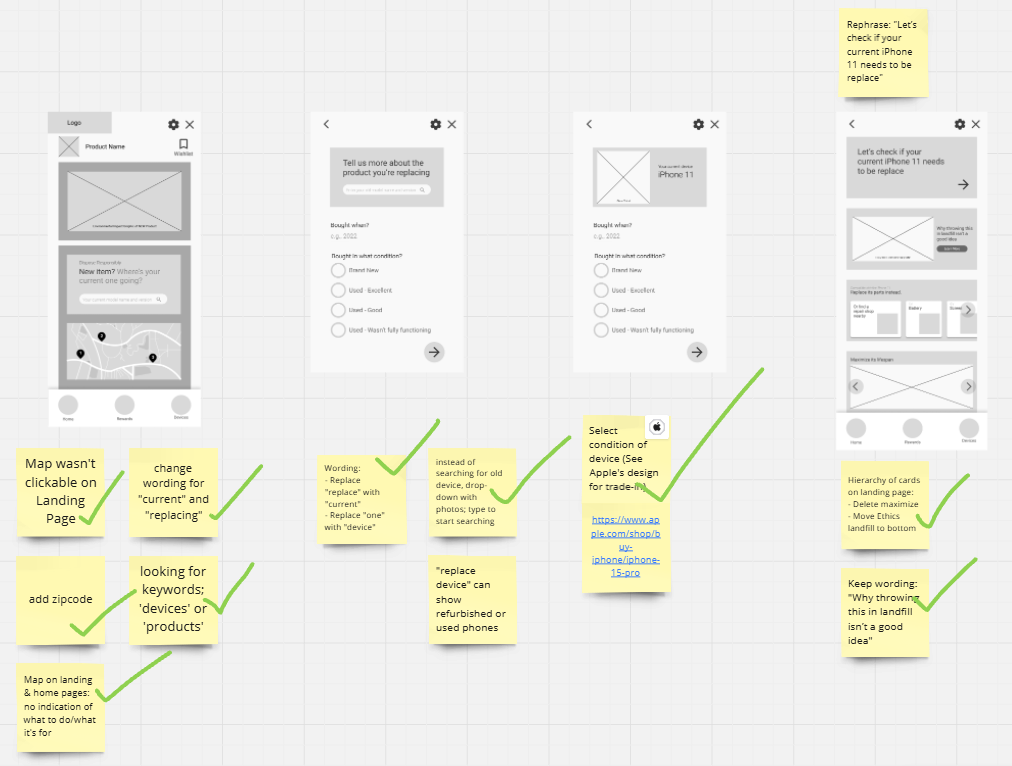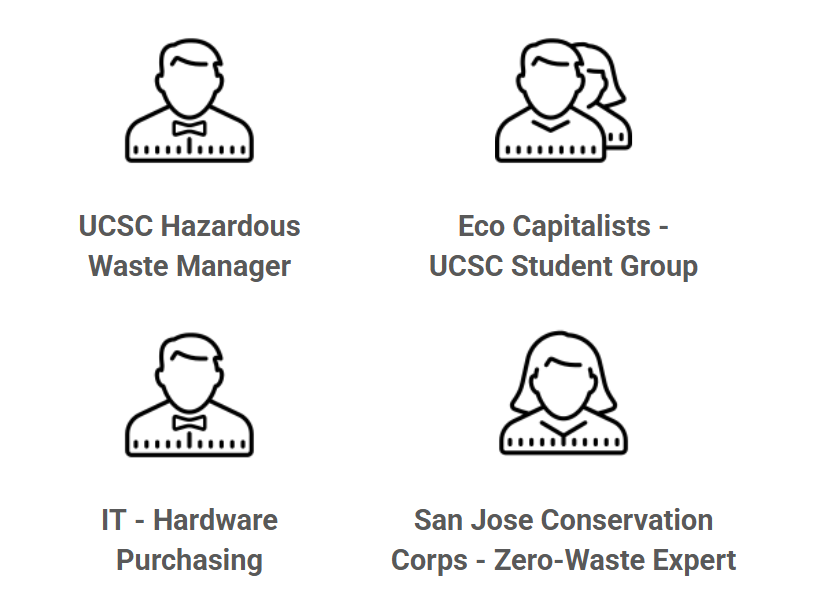Role: UX/UI Designer and Researcher, Design System
Team: Kendra Wu, Carolina Araujo, Hebah Haque
Tools: Figma, Miro, Adobe Photoshop
Duration: 10 weeks
Transform your online habits into eco-friendly wins with this browser extension.
The Problem
Only ~15% of e-waste is recycled.
Source: California Department of Toxic Substances Control
As the global use of electronic devices continues to rise, e-waste has become a significant environmental and societal challenge. Despite growing awareness, the process of disposing of, recycling, and upcycling electronic products remains fragmented and inefficient. Many users are unaware of proper e-waste disposal practices or lack access to accessible, user-friendly recycling options.
The problem is that current e-waste disposal and recycling systems are difficult to navigate, creating barriers for users to responsibly manage their old electronics. This often results in improper disposal, contributing to environmental harm and missed opportunities for reuse or recycling valuable components.
Ideation
Why tackle e-waste?
Our areas of interest fell into one of three main topics:
Carbon footprint & mining
Overconsumption & waste
Socio-environmental harm
From here, we narrowed it down to e-waste because it's where technology intersects with environmental harm.
The Solution
We propose the development of a web browser extension that helps users track their electronic purchases and educates them on proper disposal methods. The extension will integrate with e-commerce platforms to automatically log product information upon purchase, including model, warranty details, and expected lifespan.
Goal:
To simplify the management of electronics, provide proactive solutions for disposal, and make e-waste education accessible and actionable, promoting long-term environmental responsibility.
The Process
Once we identified our area of focus, we considered our time crunch and laid out our next steps followed this process.
Research I
What are the issues with e-waste?
We researched the impacts e-waste and it’s improper disposal. We found e-waste poses a complex set of challenges that disproportionately impact human health, the environment, and vulnerable labor forces, especially in the Global South.
How might we align consumer behavior with sustainable practices to address overconsumption?
Define
Why a browser extension?
A browser extension designed to tackle e-waste could address the infrequent nature of electronics purchases by providing reminders, keep users informed about ever-changing recycling policies, and make responsible disposal both fun and incentivized. By using elements of gamification, rewards, and personalized educational content, an extension could make e-waste management an easier, more engaging, and rewarding process for users, ultimately promoting sustainable practices and reducing the negative impact of e-waste on the environment and society.
Research III
Competitive Analysis
We completed a competitive analysis on platforms with similar concepts, such as websites, mobile applications, and adjacent web browser extensions. With our HMW statements and previous research, we created a grid with categories for what these platforms excelled at and what features were absent from each other. These helped us find gaps and opportunities for our own extension.
Design
Initial Prototype
map
gamification
honor system
electronics management
news - educational content
Design
User Testing
We conducted usability testing with a group of 6 participants, all proctored either in-person or remotely. We provided them our mid-fi Figma prototype an gave participants a 3 specific tasks and measured each participant’s level of completion. At the end, we asked for their feedback, features they liked, and areas of improvement.
We scored each task on a scale of 1 - 3.
1) User cannot perform task
2) User can perform task, but has some struggles
3) User can perform task with no trouble
Design
Feedback
Usability testing uncovered key points of improvement, looking specifically at tasks where users struggled to complete the task. We parsed through our notes and transcripts and with sticky notes added a specific recommendation or feedback to each frame in the prototype.
Design
Design System
Design
Hi-Fi Prototype
Product Assessment
When browsing for a new electronic on ecommerce sites, users can use Unearth to explore options for their current product by answering a series of questions.
Earn Points
Get Achievements & Redeem Points
Results
Learnings
Utilize university resources to acquire experts, particularly those in government or political movements in this space
As the project moved forward we found the scope of our project widened far from our capabilities. By limiting the key features we would be able to stay within the constraints on our timeline.
In our interviews, we learned that sending our interviewees the list of questions before the sessions would help prepare them in their answers and also save time during the interview.
Results
Next Steps
This project is attempting to tackle a very big and complex issue. If we were to continue the project, here are some points we would expand on:
Perform a 2nd usability test on the latest hi-fi.
Perform more research on the abilities and constraints of a browser extension.
Explore expanding to other types of waste in addition to e-waste.
Potentially embed pick-up scheduling for some of the disposal resources provided.
Expand incentive goals, possibly direct monetary incentives while being eco-friendly to increase new users.
Research II
Exploratory Interviews
To better understand the issues related to e-waste, we chose to interview a few experts in the field. We started by identifying potential experts. We then prepared an interview script, focusing our questions on background info & the intersection of e-waste and technology. We had limitations speaking to experts in political spaces as they were difficult to make contact with. We conducted 4 interviews, 3 remotely and 1 in-person. Each interview lasting 1 - 1.5 hours.
Interview Findings
Main themes we uncovered from our interviews include:
Human Health Impact
E-waste contains hazardous materials like lead, mercury, cadmium, and brominated flame retardants. When improperly disposed of or burned, these materials can leach into the environment and contaminate the air, water, and soil, leading to serious health issues.
Environmental Damage
Improper e-waste disposal, such as dumping or open-air burning, leads to the contamination of soil and water with toxic substances. These pollutants can enter the food chain, harming local ecosystems and affecting agricultural productivity. Many electronic devices, if not properly recycled, end up in landfills. Over time, these devices break down and release harmful chemicals into the environment.
Define
How might we…
From here, we prepared “How Might We” statements in order to identify possible solutions.
Labor Injustices
The mining of minerals for electronics, particularly those used in smartphones, laptops, and other disposable tech, has deep ties to labor injustices in the Global South. These issues are not limited to the recycling phase of e-waste but start much earlier in the supply chain with the extraction of raw materials.
How might we incentivize consumers to reduce e-waste through responsible disposal practices?







